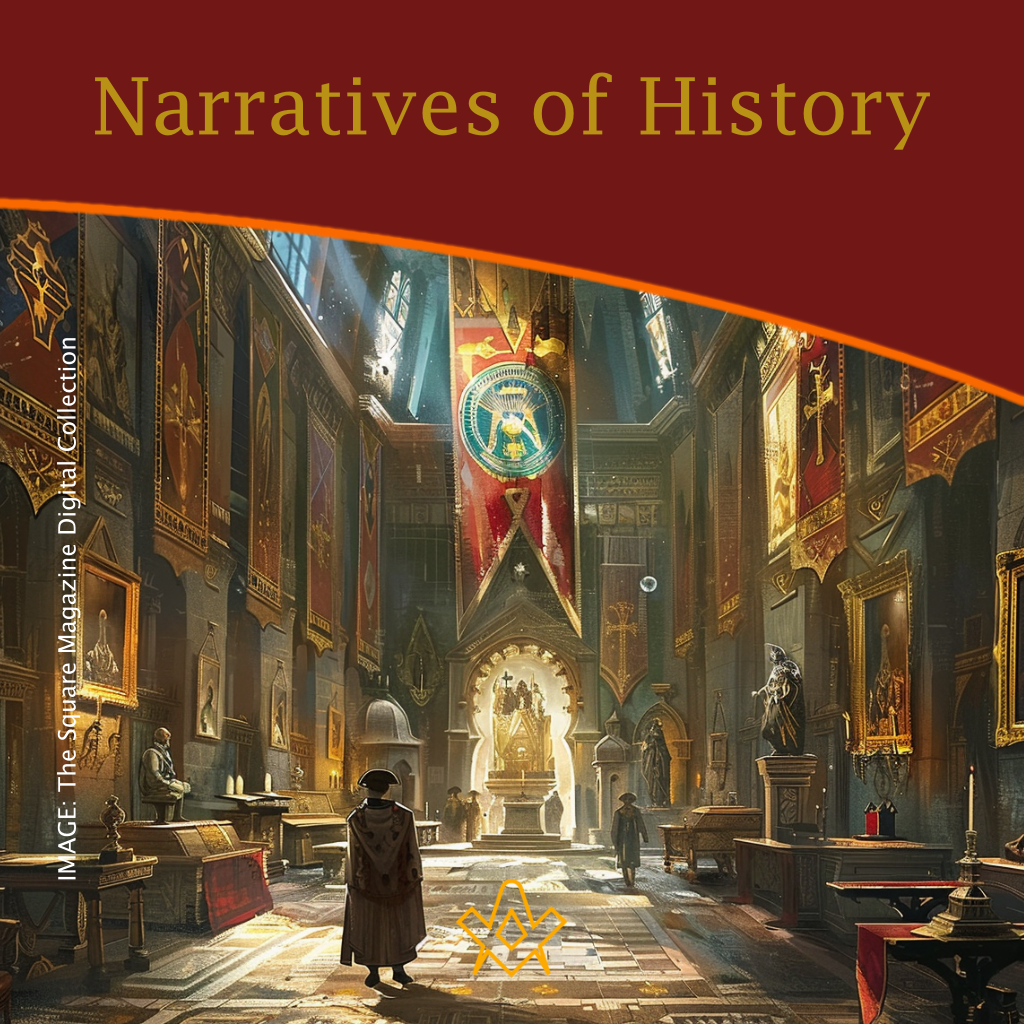In the vast tapestry of history, moments of darkness and light intertwine, shaping humanity’s journey. Yet, amidst the turmoil, the concept of Homo Novus emerges—a beacon of hope.
It’s a call to transcend past legacies and embrace a path of unified truth and freedom. Join the quest for enlightenment.
A cumbersome and dreary topic, such as History, exposes me to many challenges, even havoc since history is well-known for its mercilessness.
It originates from a fallen man who could not stand so many denials listed in the Ten Commandments.
Therefore, history relies more on our sins than our virtues. Whenever history relies on sins or an irrational mass (multitudo humana), history brutally plunges into reality, generating death: it crumbles cities, cuts families in half, abolishes frontal and sideways, and becomes a beholder of pain and grief.
Whenever history speaks of virtues, such as the Essene spiritual training school, that ascetic academy which, it seems, Jesus has attended, or like the epigraphic codex of Cretan Gortina, which was written in the seventh century BC, abolishing slavery and renouncing war, codex which was a showcase of peace and, according to some writers, should be located out of history, when history speaks by virtues, it becomes boredom, atrophy even, fabulation damage.
The Russian count, not at all mistaken, titled his novel War and Peace. Therefore, the primordial human condition, our fact, is war. Peace is a fragile pause between two hatreds.
A step further will drive us to the point where the need for an enemy is embodied in the class and religious struggle as equal impeller of history.
However, from the year nineteen forty-three, a new impeller of history is recognized: a technological development.
That is to say, for the needs of the upheaval in the Second World War, the first computer was assembled in the US, with almost twenty thousand cylindrical vacuum lamps, seventy thousand resistors, and thousands of capacitors.
It weighed over thirty-five tons and had fifty autonomous parts with a separate power supply and cooling system. It occupied a space of eighteen hundred square feet.

John Mauchly and J. Presper Eckert with their invention, the ‘Big Brain’ computer.
IMAGE: the square magazine digital collection
Naturally, nearby insects have caused thousands of short circuits and remain known as computer bugs.
The computer was served by hundreds of technicians on roller skates who were supposed to get from one end of the corridor to the other, where the signal bulb had reported a malfunction.
Physicist John Mauchly and J. Presper Eckert, are counted as the inventors of the computer (the Big Brain).
On the other hand, some sources also mention Vincent Atanasov, an addled scholar who did not report his invention on time, so his merit was erased.
That’s why his name should be added to the list of hidden heroes of civilization, a list of people whose glory was stolen from them by malignant historical forces.
In any case, technological development, as a legitimate impeller of history, has provided that in less than a year from the beginning of the Big Brain’s start working, the Atlantic finally became passable, Mother England was fed and armed, and losses of the United States were significantly reduced.
Undermining the profit structure of developed capitalism was stopped. On the other hand, Stalin and Churchill were spared further military and civil attrition. The final collapse of London and Moscow was canceled at the last minute.
The New World Empire, however, did not come to power. German was not established as an official language of Europe. The names of cities, streets, and squares have not been changed. Neither were school programs.
The European peoples in the lower flow of the Danube were not subjected to unprecedented pedantry, diligence, and discipline.
Thus, the Big Brain should even be seen as a historical necessity that crushed the infamous Third Reich.
Of course, the maturing of history immediately followed: Germany was split into two halves. Let’s presume it was calculated that the humiliation would take its part. That the rotten processes, malaise, and anomie will dominate society.
But the spirit of the people was preserved, and the Germans, albeit with a delay of two decades, achieved all the economic goals outlined by entering the II World War: a fierce economy, a strong national currency, and foreign labor. Defeat became a victory. The same case was with Japan. Historical irony had spoken.
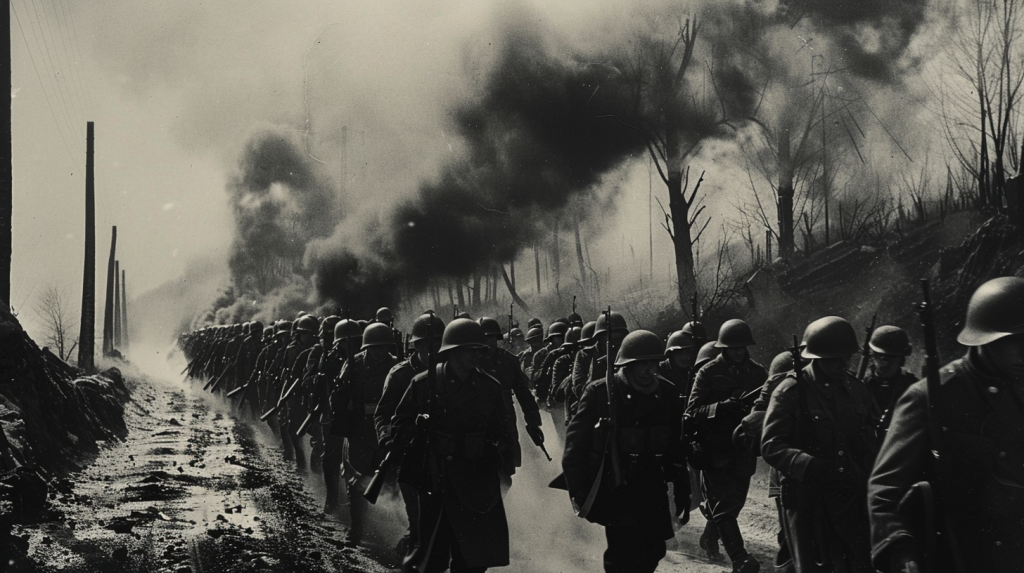
World War II – Third Reich
IMAGE: the square magazine digital collection
If the war had ended with Hitler’s victory, the state terror of the Third Reich, I suspect, would not have been stopped at the Jews but would have affected others as well, as the Nazis proclaimed: degenerative races, degenerative in an aesthetic, biological, or historical sense.
There is no doubt that this would disrupt Germany in the long term.
The moment when crime becomes a method and evil becomes tolerable and acceptable, then a mutation of mentality occurs. Carnage is a way to destroy structure.
When a person is allowed to do everything, then he does not shy away from anything, or as Hannah Arendt wrote: The Nazis trivialized evil, legalized it, and carried out the Holocaust.
That is the moment of the ultimate defeat: the mind is paralyzed, the family is truncated, the heritage is dismantled, and the edge of the permissible is annihilated. Hence, the nation itself is inevitably dying.
If we put that historical scenario aside, we will see that Alexander the Great has provided history with totality: accepted the tradition of the conquered land, respected the enslaved nobles, showed an absence of spontaneous and headless killing, raised numerous polises, and developed a civil gesture.
No one before him, nor anyone after him, managed to do so, gave up assimilation and accepted otherness.
No one except the British writer Leonard Woolf, who was the colonial administrator of a district in Ceylon in 1908, and who said: “I have witnessed the absurdity of people of one civilization and way of life, who are trying to impose their rule on a completely different civilization and way of life.” The sharpness of those words made Wolff soon to resign.
On the other hand, British colonialism over a century, when the British East India Company was in power, recorded the vicinity of forty million people who died prematurely due to famine.
The casualties could have been far more significant if India’s independence in 1947 had not been a public lesson in modern geography, the authenticity of British culture, and even a crucial sign of the power of the British Empire.
The Brits, whose white skin had already become accustomed to the warmer climate, their eyes to the fat monsoon rains, and their ginger-hunting dogs to the mighty Bengal tigers, wisely assessed the situation, packed their bags, and returned home without any noise, without a single rifle loaded.
By all means, it should be mentioned that the languor of the empire was evident and that the Brits were exhausted by the just-ended World War II, out of the power to cover the whole of India.
The opposite case was the Falklands War, when almost the entire fleet was raised to its feet, and the ocean was crossed only to safeguard British colonial property across from Argentina.
In short, at that particular moment, the colonial nerve had shown his decisiveness.
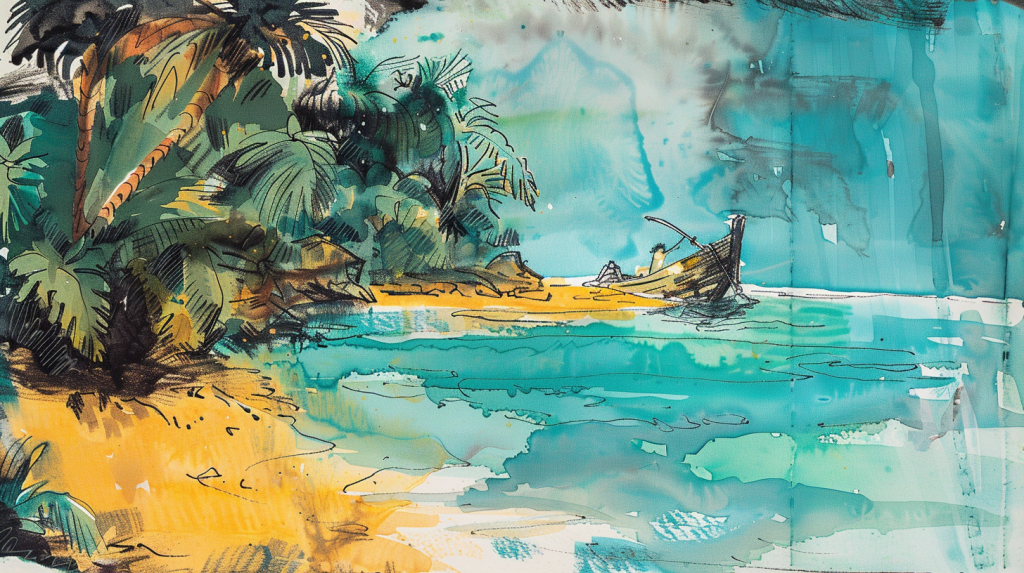
Shipwrecked tropical Island
IMAGE: the square magazine digital collection
The evident subconscious power of the mentioned nerve can be found in Daniel Defoe’s book about the far-famed shipwrecked Englishman who ended up on a cannibal island, dangerously displaced from colonial comfort but not from the colonial mind.
Further proof was given to me during my last holiday in Greece when our neighbors, two freckled twelve-year-old boys from a working-class suburb of Leeds, addressed a caught anchovy with the colonial words: You can live here if you want.
Then, they pushed the fish into a plastic bottle cut in half and filled with water.
Be that as it may, if I return to Alexander the Great and his speech to demoralized, soaked, and mired soldiers on the left banks of the Indus River, I should recall his words, probably driven by the philosophy of the East, that all the victories of the Hellenes, starting with the one over the Tribals, de facto, made the Hellenes decadent.
The same circumstance happened a century later, in ancient Rome, with the slight difference that the barbarians from the South, not the ones from the North as it was in Hellenic history, brought a solution.
Hannibal was the one who carried inevitable change. He was the one who defeated Rome. Hannibal pacified the Mighty Rome. He rounded Rome. He made a necessary antithesis. He reversed the empire.
Before him, Rome was historically vulgar and unassailable. Nolens-volens, history teems with dystopia. Furthermore, a constant repeat of rottenness, of viciousness itself, has moved history from her sacramental role: the victim and the executioner have changed their sides.
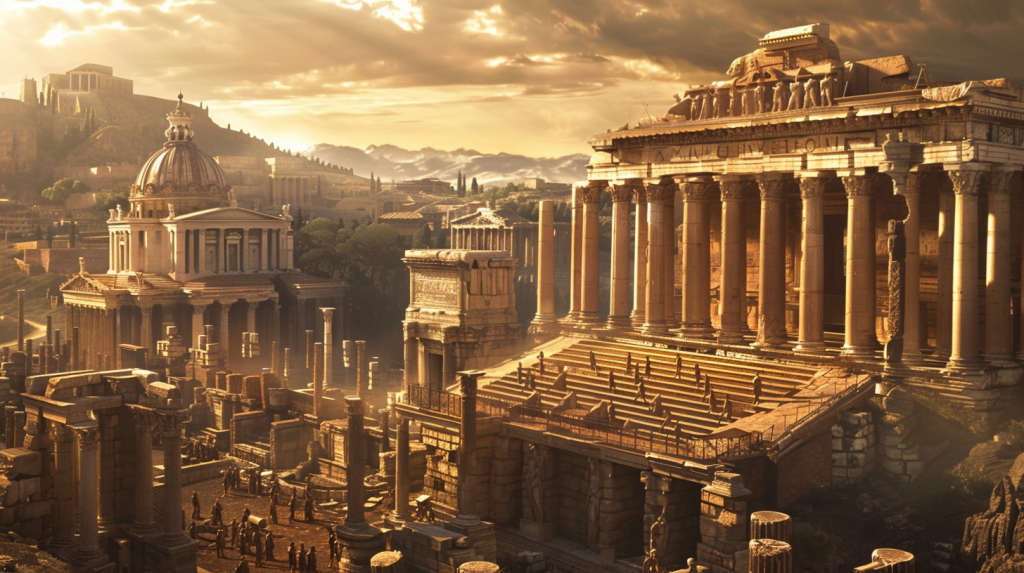
Roman Empire
IMAGE: the square magazine digital collection
History has become a sum of symmetries: Gilgamesh and Humbaba, Athens and Sparta, Persia and Hellas, Eastern and Western Roman Empires, Habsburgs and Ottomans, Red and White Roses, colonies of these and those, Catholics and Protestants, Axis powers and victorious powers, military alliances of left and right, cross and crescent, evil and penance everywhere.
Looking back at the period from the Second World War onwards, we will see that dystopian points, or places of constant strife, are multiplying all over the earth and that the dying of history can no longer be questioned.
Be that as it may, two types of dystopias are striking. Structurally opposed to each other. Dystopia in the West, almost as a matter of principle, remains at the level of controlled and isolated outbursts of violence.
Hence, it is defined as the (i)rational need of the system that makes it stable and impeccably established.
In the East, however, the bloodshed reaches enormous numbers. Any encounter devastates. Depending on the area, it measures hundreds of thousands of victims. Somewhere even more than that. Millions.
Among the most striking examples of the twentieth century are the Balkan pits and execution grounds. Over here, martyrdom is a natural state, even cherished as a (cursed) property.
That is why the Balkan is an area of excessive nations, filled with mythomania and hubris, an area of minor differences in almost everything, including war crimes and savagery.
The atrocity exhibition in the East also shed light on the Soviet gulags, the massacres of Kurds and Armenians in Turkey, the Middle East wars, the Chinese Cultural Revolution and its devastations, the Cambodian killing fields, and the Korean War.
All those dystopian points are characterized as a disruption of the primal law of nature because the excessiveness of violence occurs. Nations become more bloodthirsty.
The Latin saying: Homo homini lupus est leads the way. Along with dystopia, as a legitimate historical tool, is standing contra fatum. With its powers, that process abruptly interrupts the historical flow and takes it to the other side.
A revolutionary twist is needed: assassination, conspiracy, or rebellion. What follows is brutality, retaliation, and revenge. In case of success, that trinity strikes at the former regime or despot, but in case of failure, the plotters are executed.
Contra fatum in post-war Yugoslavia was initiated when President J. B. Tito turned his back on J. V. Stalin and made communism on his own. It lasted for decades and led directly to the fratricidal war during the nineties. Even worse, the system was so strong that some of its creepiness is present until nowadays.
The most impressive literary example is given by Hesiod (in Theogony), a writer who dealt with the Tartarus collapse, who favored the angry and resolved Zeus, his hard-won victory over father Kronos during Titanomachy, which led, as it seems, to the complete privatization of Olimp.
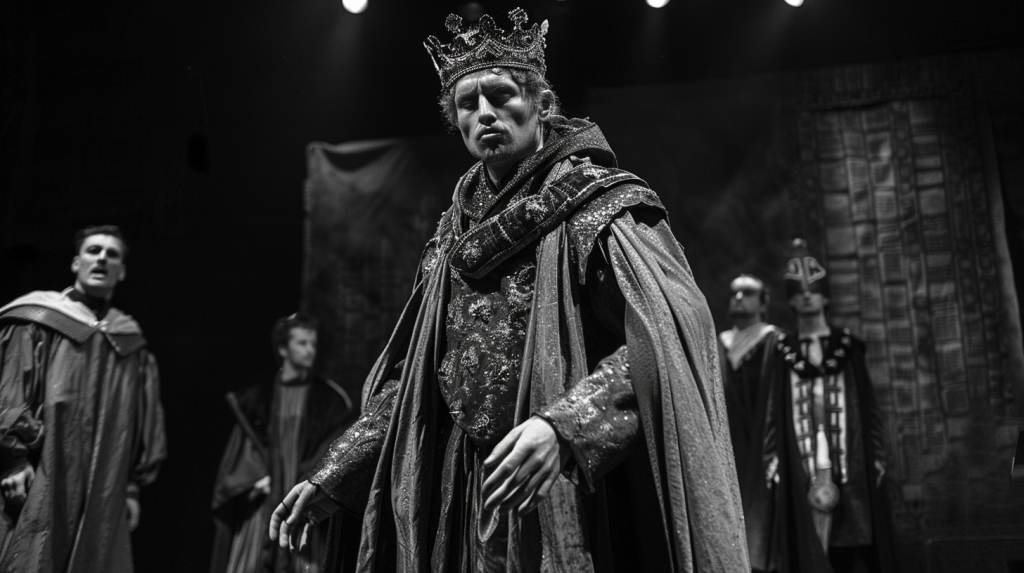
Shakespeare’s play of richard III
IMAGE: the square magazine digital collection
In medieval literature, however, it will be quite enough to be referred to Shakespeare’s plays, to Richard II, where the complot is declared sacred (“This royal throne of kings, this sceptered isle… This blessed plot, this earth, this realm, this England.”), and especially in Richard III, wherein the finale of the play is given in the scene where a kingdom for a horse is offered (“A horse! A horse! My kingdom for a horse!”).
As a writer, it is not my job to be a servant of historical events. I leave that to the encyclopedia. My vocation is to open up history and thus protect it from any finitude, especially tragedy.
Since the history is Sunday: sluggish and unwilling in the morning, but always dressed up for Sunday lunch, solemn before devouring millions, dissatisfied with the morsel itself, and wicked to sit down at the table even hungrier the following Sunday.
The knowledge of higher mysticism, the knowledge whose result is equal to despair, clearly warns us that man is cursed, constantly minor in a will, and therefore will always be those who will elevate Celsus’s two-millennia-old description of amputation to the flywheel of history, the ones who will erase others, who will grinds and tears millions, proving that the human mind is most creative in brutality and destruction, that war has become a grocery, that the world is an extremely unstable assembly.
Hence, it is up to Freemasons to resist it with all the strength possible.
Or, teleologically speaking, in the sense of purposefulness, the Brethren have an arduous task ahead to answer that cumbersome guild puzzle: Is there any other historical truth, or is history the most ordinary cadastral travesty, the constant filling of soil both with human rage and blood?
Governed by the masonic quest for truth, I am about to admit that we are at THE ALTAR OF EVERYTHING EXISTING. Fukuyama would say: At the end of history.
However, that postmodern machination about the end of the struggle of ideologies, about the point where opposites extinguish each other, actually leads us to the end of the world we know, and we know it as a Manichean creation, the unification of opposites.
Therefore, Brethren require a New Man, not at all burdened by the legacy of ancestors, the religion of blood, and death.
It is Homo Novus who, by doing what is difficult, will achieve freedom and truth. That is the right path for our Brethren, not ever to become a chronicler of disintegration.
3×3
Belgrade, 6th of january 6024 the year of true light
Article by: Draško Miletić

Draško Miletić, born in Kotor, Montenegro. He graduated from Belgrade University with a BA in tourism, but changed profession, started working as a journalist, and for fifteen years as a journalist, editor, and author in digital and news media, an editor at ART TV, the channel that specializes for cultural topics.
Since 2001, Draško dedicated himself to literature not only as a writer but also as an editor in chief of the books of poetry, essays, and short stories and the literary magazine URB, which was published monthly from 2003 to 2007.
During the period 2005-2007, he was also a teacher in the Center for Youth Creativity. As a result, three books were published. He has published in more than fifty literary and web magazines in Serbia and the region.
Draško is a member of the Serbian literary society and since 2018 has been an independent artist.
He is multilingual, speaking English and French. He lives and works in Belgrade with his wife Neda, a music teacher, and has two grown-up children.
Recent Articles: masonic history
 Protestantism and Masonic Influence in Brazil Discover the untold story of how Freemasons helped Southern Americans immigrate to Brazil post-Civil War, fostering economic and educational growth in Santa Bárbara d’Oeste and Americana. Learn about their pivotal role in establishing Protestant churches and ensuring the secularity of the Brazilian State amidst a Catholic-dominated society. |
 Explore the proper use of the sacred word in Brazilian Freemasonry through an analysis of Masonic literature and Bible translations. Uncover the errors in pronunciation and the need for corrections to maintain liturgical coherence in rituals. Discover insights on Masonry, rituals, and the Hebrew word Boaz. |
 Narratives of History |
 A Very Royal Sesquicentenary |
 Unveiling the Enigma: Discover the Royal Society's Legacy and its Impact on Science. Delve into the fascinating history of the Royal Society, the prestigious UK academy shaping scientific progress since 1660. Explore its pivotal role in advancing knowledge, fostering collaboration, and unlocking the secrets of the universe. Prepare to be amazed! |
 Knights Templar in Freemasonry Uncover the Mysteries of the Knights Templar in Freemasonry! Delve into the intriguing world where chivalry and symbolism intertwine. Discover the captivating rituals and ancient secrets behind the Knights Templar Masonic Orders. Explore the historical connection and delve into the enigmatic narratives that continue to fascinate enthusiasts today. Unveil the hidden truths now! |
 The Royal Arch stands as the rainbow of promise in the Ritual; it stands as the promise of the resurrection; of that which was lost and that it shall be recovered. The question arises as to whether the Master's Word was originally communicated in the Third Degree? On this point there is some diversity of opinion. Originally published in 1915, this insight into the Fourth Degree – the Holy Royal Arch – is as relevant today as it was over 100 years ago. |
 Unveiling the Mysteries of Druidism: Discover the Intriguing Connection with Freemasonry. Explore the ancient spiritual practice of Druidism and its fascinating ties to the enigmatic world of Freemasonry. Delve into the shared symbolism and rituals that have captivated minds for centuries. Unlock the secrets of these intertwined traditions today! |
 Uncover the legacy of freestone masons and their pivotal role in crafting medieval cathedrals. Discover the artistry behind their techniques, the hierarchy within their craft, and the enduring impact of their intricate carvings. A deep dive into the world of these master craftsmen awaits you! |
 Unearth the intriguing journey from Vincha Culture to Freemasonry. Discover how ancient building methods intertwine with modern Masonic philosophies. This exploration will shed light on the fascinating link between the Serbian term "shestarenye" and the symbolic significance of the compass in Freemasonry. |
 Freemasonry and the Illuminati Unravel the enigmatic world of Freemasonry and the Illuminati in our latest exposé. Dive into centuries-old mysteries, debunk conspiracy theories, and discover the truth behind these elusive societies. Are they puppet masters or mere myths? Join us as we dissect history and fact from fiction. |
 The Île des Templiers, or “Island of the Templars” lies within a leafy park in Paris. The execution site of Jacques du Molay, the last Grand Master of the Knights’ Templar bears a plaque with the epitaph ‘A cet endroit / Jacques de Molay / Dernier grand maître / de l'ordre du temple / a été brûlé le 18 Mars 1314’ (‘In this location / Jacques de Molay / Last grand master / of the order of the temple / was burned on 18 March 1314’) |
 Operative Progressions to Speculative Masonry Both Operative and Speculative Masonry are an important part of the modern fraternity of Freemasonry, which combines elements of both traditions. Today, Freemasonry is a fraternity that is open to men of good character, who are interested in personal development and in making a positive contribution to their communities. |
 General Regulations of a Free Mason, 1723 General Regulations of a Free Mason as contained in Anderson's Constitutions of the Freemasons, published 1723. the Regulations are of great historical interest. Compiled by George Payne, the second Grand Master of the Premier Grand Lodge of England, they were printed in 1722/3, thus published just over five years after the formation of the Grand Lodge 1717. |
 The Genesis of the 1723 Book of Constitutions 2023, marks the three hundredth anniversary of the publication of the first printed Book of Constitutions of the Grand Lodge formally established in London two years previously. This is an anniversary whose significance extends beyond freemasonry. A paper by Andrew Prescott |
 The Ritual of the Operative Free Masons - P3 Existing Operative Free Masons. The ritual I am about to refer, is that of "The Worshipful Society of Free Masons, Rough Masons, Wallers, Slaters, Paviors, Plaisterers, and Bricklayers." By Thomas Carr, M.D., P. M. Honorary Member of the Guild of Operative Free Masons |
 Liberté chérie was a Masonic Lodge founded in 1943 by Belgian Resistance fighters and other political prisoners at Esterwegen concentration camp. It was one of the few lodges of Freemasons founded within a Nazi concentration camp during the Second World War. |
 The Ritual of the Operative Free Masons - P2 If anyone doubts the fact that the formation of Speculative Free Masonry was due to and based upon Operative Free Masonry, it is quite easy to convince him of his error if he will only study the first Book of Constitutions. By Thomas Carr, M.D., P. M. Honorary Member of the Guild of Operative Free Masons |
 In 1881, Freemasonry rose from the ashes of a fire in the mining town of Kokomo, Summit County, Colorado. Corinthian Lodge No. 42, along with Kokomo, no longer exists but it holds the record of having been – at an elevation of 10,618 feet – the highest Masonic Lodge in the USA. |
 The Huguenots and Early Modern Freemasonry The Huguenots influence in the development of early modern Freemasonry at the time of the formation of the Grand Lodge in London around 1717 / 1723. |
 November is a month of reflection – perhaps due to the fact that we are getting close to the years' end – but also because Remembrance / Armistice Day (11 November) is a significant date in most countries' diaries. |
 Speculative Freemasonry, as practise by Grand Lodge of England, was officially born just over three hundred years ago, is today an international organisation, counting over six million members. It has been subjected to persecution, suppression, and abolition throughout its history. In its infancy, only a couple of decades after its official birth, it had already become a target. |
 The Ritual of the Operative Free Masons - P1 The original paper was written, first, to prove that Speculative Free Masonry was derived from Operative Free Masonry; second, to give some account of the Operative Free Masons, of their Ritual, and of their customs. By Thomas Carr, M.D., P. M. Honorary Member of the Guild of Operative Free Masons |
 American Fraternalism in the 19th and Early 20th Centuries The late 19th and early 20th centuries in the United States has been called the "Golden Age of Fraternalism." How did this come about and why was the idea of joining a fraternal organization so popular? We will explore this question and examine the regalia used by many fraternal organizations in this period. |
 Societas Draconistarum, meaning "Society of the Dragonists"– was a chivalric Order for selected nobility, founded in 1408 by Sigismund von Luxembourg, who through marriage became the King of Hungary (1387–1437) and later Holy Roman Emperor. The Order was fashioned after the military orders of the Crusades, requiring its initiates to defend the cross and fight the enemies of Christianity, in particular the Ottoman Empire. |
 The Perjured Free Mason Detected Was Samuel Prichard a perjured individual, or simply a misguided Freemason? Prichard's book "Free Masonry Dissected" published in 1730, is now used by many Masonic historians as a source of reference with regards to the introduction of the third degree into the Craft. But at the time it was published in 1730, it was not so well received by members of the Grand Lodge of England. |
 17th century and the Holy Royal Arch This article focuses on a period of transition between a point in time when we can safely and historically identify the first formation of what could be called as the ‘Royal Arch’ and the historical events that have preceded it. |
 Most Freemasons have heard the terms 'Operative' and 'Speculative' Masons, and this article helps to understand the difference: |
 Roberts' Constitutions of Freemasonry 1722 Published a year before Anderson's Constitutions, The Old Constitutions Belonging to the Ancient and Honourable SOCIETY OF Free and Accepted MASONS. Originally printed in London England; Sold by J. Roberts, in Warwick-Lane, MDCCXXII.(1722) |
 From 'Songs of religion and life', 1876 by John Stuart Blackie (1809-1895) |
 On the Antiquity of Masonic Symbolism Is the Symbolism of Masonry an inheritance derived from the old Masons who flourished before the era of the Grand Lodges (1717); or has it been borrowed from the Rosicrucians or others, after 1717? |
 Mason's Marks – from Egypt to Europe? Mason's marks have been a source of intrigue, not only to Freemasons but to historians and archaeologists. The use of simple pictograms have been employed for millennia by artisans to identify their work. But where did they originate and why? |
 The White House Foundation Stones Further to the articles in our series on the history of the stone masons, we have a rather intriguing addition. During the 1950's renovation of the White House, President Truman retrieved more than 100 stone blocks with stonemasons marks. |
 What the Goose and Gridiron Tavern is in the ancient annals of London Freemasonry, The Green Dragon Tavern is to the memories of the Free-mason, of Boston and New England. |
 Auschwitz concentration camp: video photo article taken in 2013 |
 There are two things of importance happening this day - 27 January |
 Two approaches regarding the understanding of Freemasonry |
 Masonic Research in England c1930 An article which appeared in an American Masonic magazine, c1930 and which was reproduced in England, provoking a little controversy. |
 Masonic bookplates the ‘Brethren’s spiritual coats of arms and marks’ |
 The Unlawful Societies Act of 1799 Rebellious Freemasons and the 21st century |
 In 1912, Sarah Dowd of Dromore, Ireland, found a Masonic jewel dated 1517 - a date two hundred years before the establishment of Grand Lodge... |
 Freemasonry and Fascist Regime Interesting speech by the famous historian Prof. Aldo A. Mola, who links the fascist regime with the Masonic Associations. |
 Was famous Russian poet Alexander Pushkin a Freemason? And if so, was he a member of the lodge ‘for which all the lodges in Russia were destroyed’? |
 The Importance of Masonic Research Why is accurate - or authentic - Masonic research so important? The importance of making a daily advancement in Masonic knowledge is something that The Square is passionate about promoting. |
 The Antient Noble Order of the Gormogons had a brief existence in the eighteenth century; they left few records or accomplishments, |
masonic knowledge
to be a better citizen of the world
share the square with two brothers

click image to open email app on mobile device
